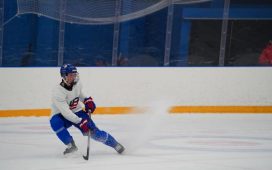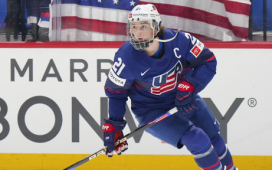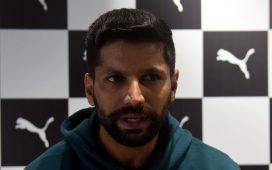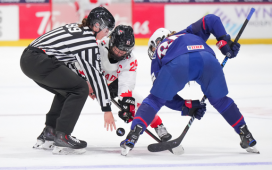The Flyers’ mediocre start to the season might not strike fear into the hearts of opponents, but Philadelphia’s play-controlling ways could make them a threat in the Eastern Conference once the top players start to click.

Waking up Friday morning, there are few who will look at the standings and fear the Philadelphia Flyers. And, hey, that’s not without reason. Through eight games, the Flyers are a modest 4-3-1, a middling team on the outside of the final wild-card spot looking in as the campaign approaches the end of its final month.
Truthfully, too, there aren’t going to be many surprised about where Philadelphia finds itself in the standings at the moment. Entering the season, there was a feeling that this was a season that could go either way for the Flyers. Considered a post-season contender in the Metropolitan Division? Sure. One of the Eastern Conference’s elite, though? Hardly. There were changes made to the roster – Kevin Hayes, Matt Niskanen and Justin Braun were brought aboard – and a change made behind the bench, with Dave Hakstol out and interim Scott Gordon replaced by veteran bench boss Alain Vigneault. But still, the jury was largely out, some considering them a wild-card threat and nothing more.
The deeper one digs, though, the more it appears there’s more to these Flyers than meets the eye, and Thursday’s dominant win over the Chicago Blackhawks was proof positive of what Philadelphia can do when it gets rolling.
In a contest in which the Flyers had a pair of goals called back, which was the only thing that kept a seemingly close 4-1 contest from being a 6-1 laugher in Philadelphia’s favor, the shot totals and underlying numbers might suggest the two sides played a fairly even outing. But it was clear that one team was controlling the run of play, particularly through the first two frames. By the time the second period ended (mercifully for the Blackhawks), the Flyers boasted 55 percent of the shot attempts, 67 percent of the shots, 67 percent of the scoring chances and 62 percent of the high-danger chances at five-a-side. And regardless of their record, that kind of thorough 5-on-5 dominance is exactly what Philadelphia has shown through the opening weeks of the season.
Dominance is the word for the Flyers’ underlying numbers, too. While it’s an admittedly small, eight-game sample, Philadelphia left Thursday’s victory leading the league in Corsi percentage (54.6), fourth in shots percentage (54.7), first in scoring chances percentage (56.5), first in high-danger chances percentage (63.1) and first in expected goals percentage (59.6) at five-a-side. Those rankings and numbers largely hold when adjusting for score and venue, too, some even improving slightly.
It can’t be overlooked what a marked improvement those numbers are from last season, either, which speaks volumes about what Vigneault has done with this group. Of the advanced statistical categories noted above, there is not a single percentage or per-60-minute rate that has declined from last season through the first eight games, and some have seen eye-popping improvements. Most notably, the Flyers are currently allowing 11.4 fewer shot attempts against and 5.3 fewer shots against per hour of play at 5-on-5. And while we can hardly expect such massive swings to hold through the duration of the season, particularly when we’re measuring these totals after one-tenth of the campaign, the early returns are undoubtedly promising.
Granted, process only means so much if it’s not followed by results, and there does appear to be one prominent issue in Philadelphia through the early going. Barring the play of second-liners Travis Konecny and Oskar Lindblom, there has been a lack of standout individual performances from the big guns. Konecny’s 11 points have him lapping the five-point outputs the Flyers have received from Claude Giroux, Sean Couturier and Ivan Provorov, all the while Konecny finds himself at least six points clear of everyone else on the roster. That includes high-priced wingers Jakub Voracek and James van Riemsdyk, who earn a combined $15.25 million yet have mustered just three goals and six points between them.
What gives hope for a turnaround for those players, however, is that seemingly all are going through a bout of dreadful shooting luck. Giroux has converted on a mere four percent of his shots on goal, Couturier on eight percent and van Riemsdyk, who is leading the Flyers with 37 shots, on 2.7 percent. All three players boast career average shooting percentages of 11 percent or greater, too, so it’s safe to suggest that the true shooting talent of the trio will come to the fore if the Flyers continue to generate as they have through the early season.
But it’s not just the offensive stars who are struggling. In much the same way Konecny has been forced to lead the offense, Brian Elliott has needed to play lights out in his three starts to mitigate Carter Hart’s rough start to the season. In his five appearances this season, the second-year netminder has a mere .890 save percentage, which pales in comparison to the .933 SP Elliott has managed when facing nearly the same number of shots against. It could simply be a bout of early growing pains for Hart or it could be the start of a sophomore slump. Either way, this is exactly why Elliott was retained as a veteran second-stringer. He can shoulder the load should his young counterpart stumble.
So, is anyone fearing the Flyers as they wake up Friday? Not quite. But if the results catch up to the process and the Flyers’ stars start to heat up or catch fire, there’s reason to believe Philadelphia has all the makings of a sleeper in the Eastern Conference.
Want more in-depth features, analysis and an All-Access pass to the latest content? Subscribe to The Hockey News magazine.








